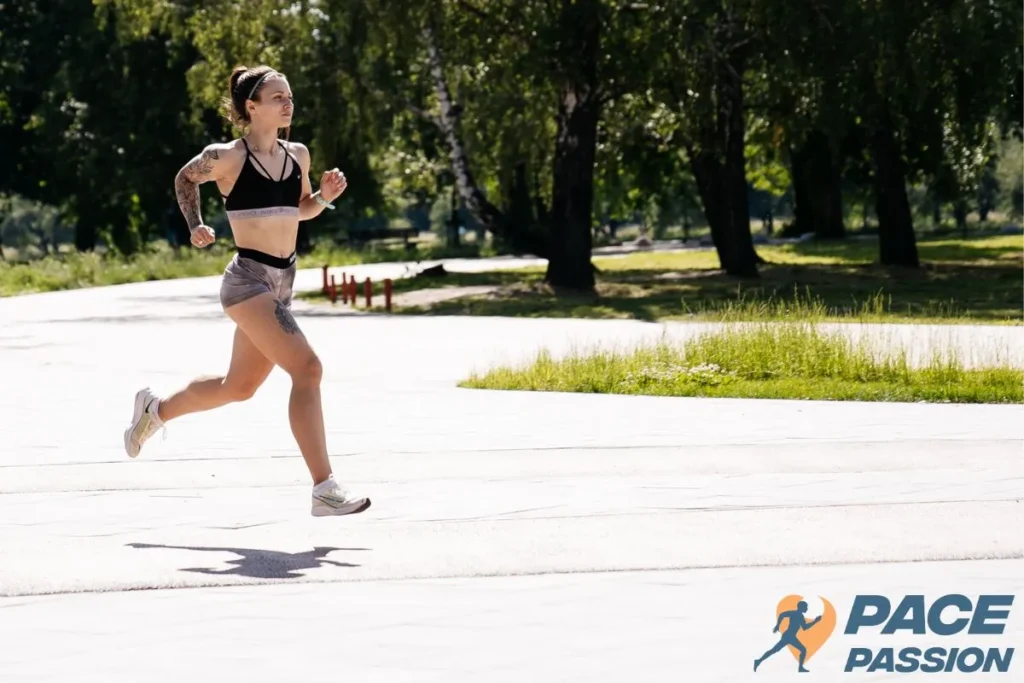All of the Advantages and Disadvantages of Fartlek Training
A combination of walking, jogging, running, and sprinting intervals, Fartlek can make your training sessions a lot more enjoyable than traditional workouts. However, there are both advantages and disadvantages of Fartlek training that must be taken into consideration.
In this article, we discuss these pros and cons, as well as how to properly incorporate Fartlek training into your routine for optimal results. Whether you’re a beginner looking for a challenge or an experienced runner looking to bump up your performance, Fartlek has something to offer everyone!
What Are the Benefits of Fartlek Training and Are There Any Risks for Runners?
What are the main advantages and disadvantages of Fartlek training? Fartlek helps runners improve their endurance, speed, and range of motion. Benefits include improved muscular strength and burning calories faster than with steady-state cardio. Disadvantages of Fartlek training include risk of injury for inexperienced runners.

What Is Fartlek Training?
What is Fartlek running and how does it differ from regular sprint intervals? Fartlek training is a type of running that helps improve the aerobic performance and physical condition of runners. It involves alternating between a fast and slow pace, without any predetermined distances or time references (unlike other forms of interval training that involve pre-defined intensity bouts at set intervals).
One particular way Fartlek adapts itself to all levels of fitness is in its ability to change the ratio or distance of each training session, making it almost infinitely customizable for both beginners and advanced runners.
Fartlek training also combines both anaerobic and aerobic elements, making it highly effective for overall fitness, as well as for helping to target different energy sources in your body.
8 Advantages of Fartlek Training
Fartlek training offers countless benefits to all levels of athletes, from beginners to seasoned pros.
1. Improves Endurance
Fartlek training is a form of speed training that helps runners increase their endurance by gradually improving fitness through continuous workouts. Unlike traditional interval training, where specific distances are predetermined and timed, the dynamic nature of Fartlek allows for an adaptable plan tailored to any fitness level.
Through Fartlek training, runners can build up their endurance safely while taking into account their own personal fitness levels for optimal results.
2. Improves Speed
This training method centers on varying your pace within a single workout, allowing you to move between periods of high-intensity effort and lower-intensity effort over the course of multiple intervals.
By changing up your pace, Fartlek training improves the body’s ability to handle different levels of strain while working out, making it easier for runners to adapt quickly and efficiently when racing.
3. Adaptable for All Training Phases
Fartlek training provides versatile, diverse, motivating workouts to add variety to a runner’s program. It can be incorporated into all stages of the training cycle, including base building, speed work, and race preparation.
Its adaptable format makes it suitable for all levels of runners, from beginner racers to professional athletes.

Pro Tip:
By varying intensity and duration, or adding other components such as squats or jumping jacks in between intervals, you can be sure your body is never overworked, and still enjoy great results.

Pro Tip:
By varying intensity and duration, or adding other components such as squats or jumping jacks in between intervals, you can be sure your body is never overworked, and still enjoy great results.
4. Provides Diversity
Continuous training has its advantages and disadvantages, and one of the disadvantages is boredom. Fartlek training provides diversity, allowing runners to break up monotonous steady-state cardio with high-intensity bursts of energy during their runs. This adds variety not only to the intensity, but also in regards to terrain, ensuring that no two runs are ever exactly the same.
This form of training encourages runners to work different muscles as they switch between different paces and intervals throughout the workout. Fartlek training works both mind and body, adding creativity while providing diverse physical benefits.

5. Improves Mental Strength
Fartlek training also helps build mental strength. Running can be physically demanding, but Fartlek takes it a step further by pushing runners out of their comfort zones.
This develops mental resilience. Rather than become overwhelmed (as athletes sometimes do mid-race), you develop greater determination to complete the task. By shaping your workout plan around these unstructured intervals, you gain better focus and develop more motivation during longer races.
6. Prepares Runners for Race Day
By incorporating varying speeds, Fartlek challenges the body to adapt and condition itself for longer distances. This helps improve endurance and speed on race day, since running conditions in races are rarely perfect from start to finish.
Fartlek training also allows for flexibility, depending on individual goals. Intervals can be arranged around time, distance, or terrain. You can also alternate between high-intensity sprints and steady jogs or low-intensity exercise in order to get the most out of each session.
Subscribe to Our Running Newsletter!
Get free running tips from renowned professional athletes and discounts from top-notch brands.
7. Suitable for All Levels
Fartlek training is an excellent choice of exercise for runners of all skill and fitness levels. It allows both beginners and experienced runners to adapt their workouts in order to reach their individual goals.
Beginners are able to start with shorter intervals and then gradually increase the intensity as they become stronger. Experienced athletes can modify Fartlek training by increasing pace and duration, as well as incorporating hills into sprint intervals.
8. Burns More Calories
This high-intensity interval exercise helps improve metabolic rate and fat burning while improving cardiorespiratory fitness at the same time. Fartlek training is an excellent way for runners to maximize calorie burning.
For instance, doing a long run workout with 30 seconds of sprinting followed by 90 seconds jogging is more effective for burning more calories than just jogging continuously without breaks.
4 Disadvantages of Fartlek Training and Ways to Overcome Them
What are the disadvantages of fartlek training? Fartlek training can have some disadvantages. However, there are some simple ways to overcome them.

1. Can Be Misleading
When it comes to tracking pace and performance, fartlek training can be misleading for some runners. Unlike other forms of interval and speed training, which provide accurate information about pace, Fartlek runs are unstructured, allowing the runner to vary their intensity as they wish.
Fartlek sessions don’t have a set pattern or structure to follow, which can make it difficult for a runner to accurately track progress towards specific goals or personal records.
2. Imbalanced Training Plan
When engaging in Fartlek training, it is essential to implement a balanced workout that takes into account your physical and mental limitations. Although this running style may provide various advantages for runners, it can also lead to imbalanced workout plans, which can lead to muscle imbalances and increased risk of injury.
This can happen when an athlete engages in mostly fast or slow intervals, neglects other parts of the overall plan, increases the pace too quickly, or only focuses on endurance sessions.

Pro Tip:
One effective way to minimize these risks is by incorporating strength training and cross-training in your workout plan.

Pro Tip:
One effective way to minimize these risks is by incorporating strength training and cross-training in your workout plan.
3. Increased Risk of Injury for Beginners
Beginner runners are at an increased risk of injury when participating in Fartlek training due to the demands it places on their muscles and joints.
Beginners may not yet be used to the high-intensity periods they experience during Fartlek, or how hard they must push themselves within these short intervals. Poor breathing technique, form, and execution can lead to strain or tension build-up in key areas, increasing the risk of muscle fatigue, joint stress, and potential injury.
4. Requires Creativity
Fartlek training requires a high degree of creativity. Whether you are training by yourself or in a group, you need to continually switch up the workout to keep it interesting and challenging.
It can be difficult for runners to come up with new ideas on their own, which is why it is a good idea to seek outside inspiration, such as by following fitness blogs or joining running groups.
By regularly mixing up your workouts, not only will you improve your running speed and endurance, you will also become stronger mentally and learn how to prepare for race day scenarios.
How Is Fartlek Training Different from Other Forms of Speed Training?
Unlike tempo runs or interval training that requires runners to structure their workouts by time, fartlek is unstructured and a lot more flexible. This allows for adaptation to different speeds during different phases of the workout, without compromising your goal or performance level.
In addition, due to its flexibility, Fartlek is suitable for any fitness level or experience, whether you are looking to incorporate speed into your marathon prep or taking up jogging as a hobby.
Unlike traditional speed workouts, which can often be monotonous and tedious, Fartlek allows for an element of spontaneity and playfulness, since you do not have to commit yourself to specific times or pacing targets.
Top 3 Workouts to Improve Running in Fartlek Training
Different Fartlek workouts can be designed to improve running performance. Let’s discuss 3 different exercises you can add to your run.
1. Long Run Surges
Long run surges are an innovative way to incorporate faster running into a Fartlek training program. This type of speed work is designed to challenge the body’s aerobic capacity and improve running pace over longer distances.
The idea behind long run surges is to add short sprints or fast intervals throughout a medium-distance run, where maintaining a steady pace might not be possible. Long run surges can be incorporated into your workout plan once or twice each week, depending on need and goals.
An example might be warming up with 10 minutes of easy jogging, followed by alternating between a 5-minute-mile pace for 1 minute and an 8-minute-mile pace for 3 minutes.
2. Pyramid Fartlek
Pyramid Fartlek is a structured form of speed training that uses intervals and recovery periods to build stamina, power, and endurance. The workout consists of jogging and sprinting intervals of different durations.
This structure increases in intensity before scaling back down as the session progresses. So it may look like:
- 1 minute jog
- 2 minutes sprint
- 3 minutes jog
- 4 minutes sprint
- 5 minutes jog
- 6 minutes sprint
- 5 minutes jog
- 4 minutes sprint
- 3 minutes jog
- 2 minutes sprint
- 1 minute jog
You can set your own periods, but be sure to increase the intervals and then decrease them accordingly.
3. Music Fartlek
Music Fartlek is a unique type of workout that can be used to improve your running training program. It involves using music as a cue to control the intensity and duration of intervals throughout the session.
While any type of fast-paced music can be used, incorporating genres such as rock or hip hop is most effective in providing an extra boost during intense intervals. You can choose any duration that fits your playlist, like increasing speed for one song and resting for two, or sprinting at maximum effort for several bars.

Frequently Asked Questions About the Advantages and Disadvantages of Fartlek Training
Where Can Fartlek Training Be Done?
Fartlek training is an incredibly versatile form of speed and interval training that can be done in various settings. Whether it is done outdoors or indoors, there are many options available to runners who want to incorporate Fartlek into their fitness regimens.
What Is Fartlek Training Best for?
Fartlek training is one of the best forms of speed training for runners. It is a great way to improve endurance, pacing, and overall stamina by challenging the body with changing speeds.
Is Fartlek Training Aerobic or Anaerobic?
Fartlek training combines both aerobic steady-state cardio and anaerobic short sprints during high-intensity intervals. This type of training includes bursts of faster speeds mixed with more moderate segments and can be a great way to improve both aerobic and anaerobic endurance.
How Does Fartlek Training Improve Cardiovascular Endurance?
This type of speed training helps to increase the heart rate and challenge the cardiovascular system. It forces the body to move quickly from a resting state into a period of greater exertion, which strengthens the heart.
Final Thoughts on the Advantages and Disadvantages of Fartlek Training
Overall, Fartlek training offers excellent advantages for both beginner and experienced runners alike. It helps to improve endurance, speed, and mental strength, while providing adaptability for all types of training phases.
At the same time, it adds diversity to your running routine by introducing different speeds in one workout. However, as with any type of running or exercise program, there are potential risks, such as injury, overtraining, and imbalance in your training plan.
Now that you know everything about interval training – advantages and disadvantages, you can plan fun training runs. Whether you are running 5Ks or marathons, Fartlek provides a host of benefits, from improved endurance levels to increased muscle power.
Have you ever tried Fartlek runs? Please share your experience in the comments below.
Also Read:
- Can Women Wear Men’s Running Shoes
- Does Running Tone Your Body
- Running 20 Minutes a Day
- Best Running Shoes for Concrete
- Best Belly Band for Running
- Best Shoes for Peroneal Tendonitis
- How Much Do Boxers Run
References:
- Christopher G R Perry et al. “High-intensity aerobic interval training increases fat and carbohydrate metabolic capacities in human skeletal muscle.” Applied physiology, nutrition, and metabolism = Physiologie appliquee, nutrition et metabolisme vol. 33,6 (2008): 1112-23 https://www.researchgate.net/publication/23669655_High-intensity_aerobic_interval_training_increases_fat_and_carbohydrate_metabolic_capacities_in_human_skeletal_muscle
- Glenn A Gaesser, et al. “High-intensity interval training for health and fitness: can less be more?.” Journal of applied physiology (Bethesda, Md. : 1985) vol. 111,6 (2011): 1540-1 https://journals.physiology.org/doi/full/10.1152/japplphysiol.01237.2011
- Katie M Heinrich et al. “High-intensity compared to moderate-intensity training for exercise initiation, enjoyment, adherence, and intentions: an intervention study.” BMC public health vol. 14 789. 3 Aug. 2014 https://bmcpublichealth.biomedcentral.com/articles/10.1186/1471-2458-14-789
- Luke J Connolly et al. “Effects of self-paced interval and continuous training on health markers in women.” European journal of applied physiology vol. 117,11 (2017) https://link.springer.com/article/10.1007/s00421-017-3715-9
- Tim Shiraev. “Evidence based exercise – clinical benefits of high intensity interval training.” Australian family physician vol. 41,12 (2012): 960-2. https://www.racgp.org.au/download/Documents/AFP/2012/December/201212shiraev.pdf
If you have any questions or suggestions, you can contact us via email – [email protected]






